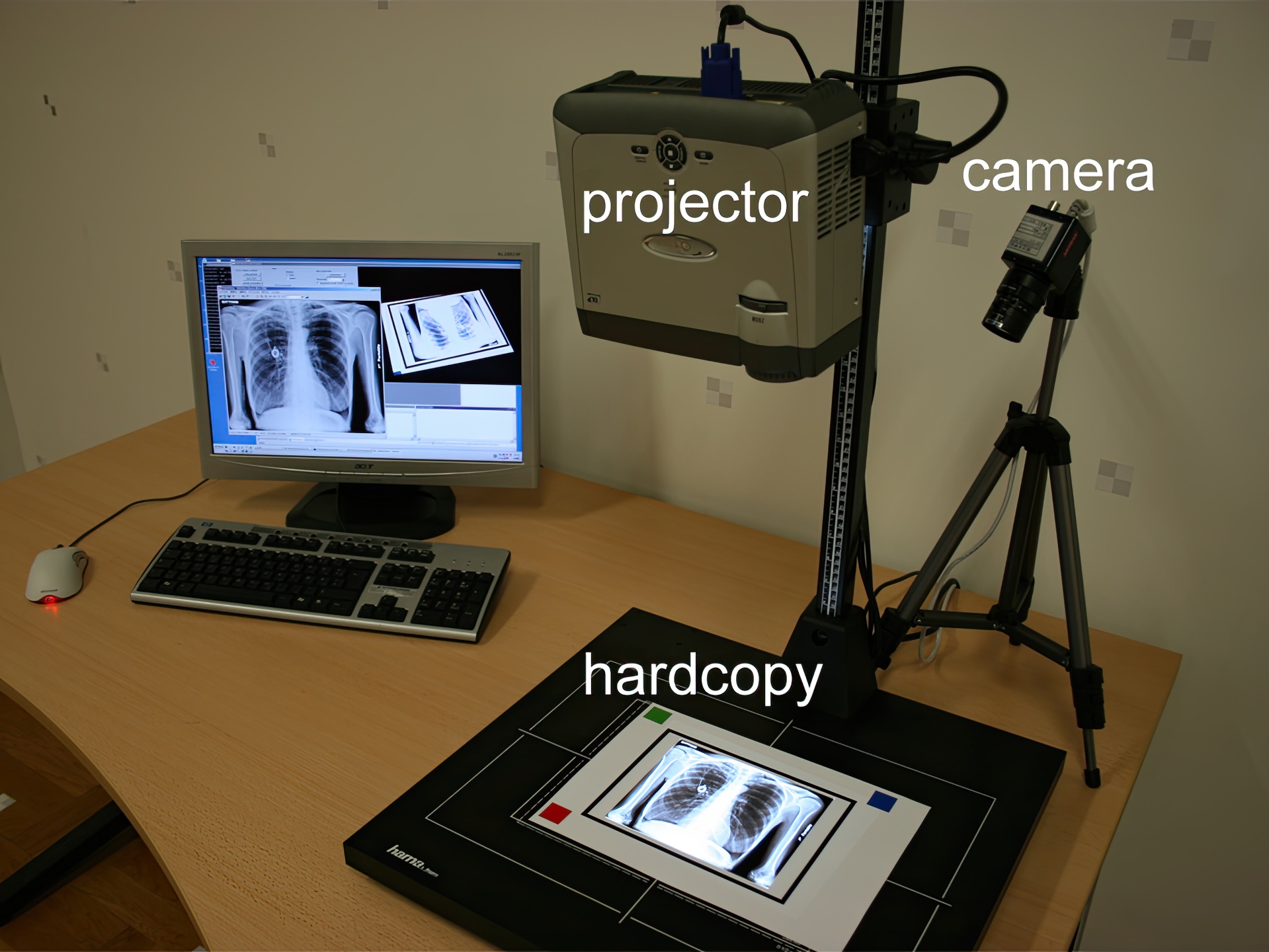“Superimposing dynamic range”
Conference:
Type(s):
Title:
- Superimposing dynamic range
Session/Category Title: Colourisation & upsampling
Presenter(s)/Author(s):
Abstract:
We present a simple and cost-efficient way of extending contrast, perceived tonal resolution, and color space of reflective media, such as paper prints, hardcopy photographs, or electronic paper displays. A calibrated projector-camera system is applied for automatic registration, radiometric scanning and superimposition. A second modulation of the projected light on the surface of such media results in a high dynamic range visualization. This holds application potential for a variety of domains, such as radiology, astronomy, optical microscopy, conservation and restoration of historic art, modern art and entertainment installations.
References:
1. Akyüz, A. O., Fleming, R., Riecke, B. E., Reinhard, E., and Bülthoff, H. H. 2007. Do hdr displays support ldr content?: a psychophysical evaluation. In Proc. ACM Siggraph, vol. 26, 38.2–38.7. Google ScholarDigital Library
2. Banterle, F., Ledda, P., Debattista, K., and Chalmers, A. 2006. Inverse tone mapping. In Proc. Conference on Computer Graphics and Interactive Techniques in Australasia and Southeast Asia, 349–356. Google Scholar
3. Bimber, O., Iwai, D., Wetzstein, G., and Grundhoefer, A. 2007. The Visual Computing of Projector-Camera Systems. In Proc. Eurographics (State-of-the-Art Report), 23–46.Google Scholar
4. Brown, M., Majumder, A., and Yang, R. 2005. Camera Based Calibration Techniques for Seamless Multi-Projector Displays. IEEE Trans. on Visualization and Computer Graphics 11, 2, 193–206. Google ScholarDigital Library
5. Damberg, G., Seetzen, H., Ward, G., Heidrich, W., and Whitehead, L. 2007. High dynamic range projection systems. In Society of Information Displays Symposium Digest, vol. 38, 4–7.Google Scholar
6. Debevec, P. E., and Malik, J. 1997. Recovering high dynamic range radiance maps from photographs. In Proc. ACM Siggraph, 369–378. Google Scholar
7. Deeley, R., Drasdo, N., and Charman, W. N. 1991. A simple parametric model of the human ocular modulation transfer function. Ophthalmology and Physiological Optics 11, 9193.Google ScholarCross Ref
8. Ghosh, A., Trentacoste, M., and Heidrich, W. 2005. Volume rendering for high dynamic range displays. In Proc. EG/IEEE VGTC Workshop on Volume Graphics, 91–231. Google Scholar
9. Grossberg, M., Peri, H., Nayar, S., and Belhumeur, P. 2004. Making One Object Look Like Another: Controlling Appearance using a Projector-Camera System. In Proc. IEEE Conference on Computer Vision and Pattern Recognition, vol. I, 452–459.Google Scholar
10. Kusakabe, Y., Kanazawa, M., Nojiri, Y., Furuya, M., and Yoshimura, M. 2006. YC-separation Type Projector with Double Modulation. In Proc. International Display Workshop, 1959–1962.Google Scholar
11. Ledda, P., Ward, G., and Chalmers, A. 2003. A wide field, high dynamic range, stereographic viewer. In Proc. Conference on Computer Graphics and Interactive Techniques in Australasia and Southeast Asia, 237–244. Google Scholar
12. Lepetit, V., and Fua, P. 2006. Keypoint recognition using randomized trees. IEEE Trans. on Pattern Analysis Machine Intelligence 28, 9, 1465–1479. Google ScholarDigital Library
13. Majumder, A., and Welch, G. 2001. Computer graphics optique: Optical superposition of projected computer graphics. In Proc. Fifth Immersive Projection Technology Workshop. Google Scholar
14. Mann, S., and Picard, R. 1995. Being ‘undigital’ with digital cameras: Extending dynamic range by combining differently exposed pictures. In Proc. IS&T 46th annual conference, 422–428.Google Scholar
15. Mantiuk, R., Krawczyk, G., Myszkowski, K., and Seidel, H.-P. 2004. Perception-motivated high dynamic range video encoding. In Proc. ACM Siggraph, vol. 23, 733–741. Google ScholarDigital Library
16. Mantiuk, R., Daly, S. J., Myszkowski, K., and Seidel, H.-P. 2005. Predicting visible differences in high dynamic range images — model and its calibration. In Proc. IS&T/SPIE’s Annual Symposium on Electronic Imaging, vol. 5666, 204–214.Google Scholar
17. Moon, P., and Spencer, D. 1944. On the stiles-crawford effect. Journal of the Optical Society of America 34, 319–329.Google ScholarCross Ref
18. Pavlovych, A., and Stuerzlinger, W. 2005. A High-Dynamic Range Projection System. In Proc. SPIE annual meeting, vol. 5969.Google Scholar
19. Reinhard, E., Stark, M., Shirley, P., and Ferwerda, J. 2002. Photographic tone reproduction for digital images. In Proc. ACM Siggraph, vol. 21, 267–276. Google ScholarDigital Library
20. Rosink, J., Chestakov, D., Rajae-Joordens, R., Albani, L., Arends, M., and Heeten, G. 2006. Innovative lcd displays solutions for diagnostic image accuracy. In Proc. Radiological Society of North America annual meeting, electronic abstract.Google Scholar
21. Seetzen, H., Whitehead, L. A., and Ward, G. 2003. A high dynamic range display using low and high resolution modulators. In Proc. Society for Information Display, 1450–1453.Google Scholar
22. Seetzen, H., Heidrich, W., Stuerzlinger, W., Ward, G., Whitehead, L., Trentacoste, M., Ghosh, A., and Vorozcovs, A. 2004. High dynamic range display systems. In Proc. ACM Siggraph, 760–768. Google Scholar
23. Trentacoste, M., Heidrich, W., Whitehead, L., Seetzen, H., and Ward, G. 2007. Photometric image processing for high dynamic range displays. J. Visual Communication and Image Representation 18, 5, 439–451. Google ScholarDigital Library





